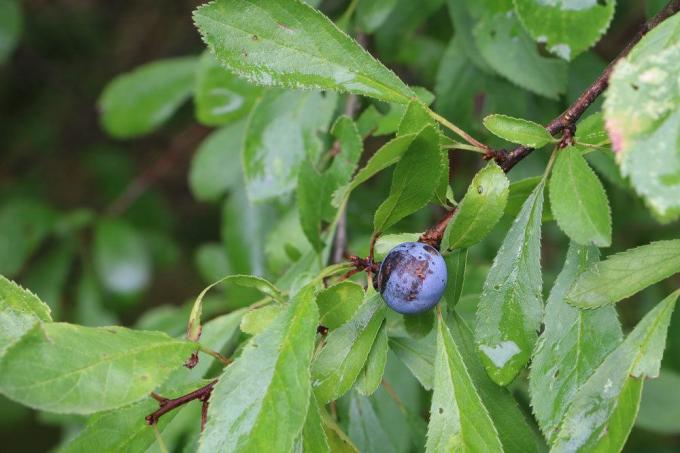
table of contents
- Are sloes poisonous when raw?
- Sour / bitter taste
- Adristing
- edibility
The sloe, also referred to by biologists as Prunus spinosa, is often found with its distinctive spines and deep dark blue berries and is accordingly known. In the past, the fruits of this type of wild plum were very popular for juices, liqueurs and jams and have recently been enjoying increasing attention again. But what is it about the well-known wisdom that the fruit of the sloe is poisonous raw and can only be consumed in processed form?
Are sloes poisonous when raw?
First of all, this question can be answered with yes when viewed objectively. This is because the kernels of the sloe, which can be attributed to stone fruit, contain the hydrogen cyanide glycoside amygdalin, which increases in the human body after consumption Hydrocyanic acid is converted. At this point, however, one should put things into perspective, since other pome fruit kernels also contain the same substance. The amygdalin content of apple seeds or bitter almonds is significantly higher than that of sloe berries. In addition, it should be emphasized that the peel and pulp of the sloe do not contain this substance and are therefore not toxic and completely harmless from a purely medical point of view. In general, sloe berries should not be eaten with their kernels. But even eating individual kernels is to be regarded as harmless.
It is different with children, especially toddlers. Your organism is not yet able to break down the prussic acid in the required amount. The consequence of eating sloe kernels is then quickly diarrhea and vomiting!
Note: Raw sloes are completely harmless and non-toxic for animals, especially birds. Therefore, the thorny shrubs are not only popular retreats and even breeding grounds for birds, but also an important source of food in the onset of winter.
Sour / bitter taste
But where does the general and persistent view that sloes are poisonous come from? If you try a Prunus Spinosa berry early in autumn, this question will almost answer itself. Because when consumed raw, the berries initially have a very sour and sometimes tart-bitter taste. This taste is mainly caused by the high proportion of tannic acids in the pulp. Looking back at the question of the toxicity of the berries, it can be emphasized here that the tannic acids admittedly have a strong negative influence on the taste, but in no way in any relation to a possible toxicity stands.

Note: Particularly sensitive people can indeed react to the tannic acid content if they consume too much. In this case, however, it is in no way a matter of poisonous substances from the sloe, but rather of a particular sensitivity or sensitivity of the individual person.
Adristing
One reads again and again that raw sloes have both a laxative and astringent effect. As mentioned, the laxative effect only occurs in very sensitive people or when consuming very large quantities of the berries. The same applies to the astringent effect. In medicine, this means the property of contraction of vessels. However, this effect is of particular importance for the medical application of the ingredients. It does not have to be taken into account when eating “normal” quantities. Since the harvest of the sloe is very laborious, the maximum amount of berries consumed should regulate itself anyway.
edibility
Nevertheless, there is a possibility to eat the fruit of sloe raw and to enjoy it. Because if you wait for the first frost, the berries suddenly become tasty without losing their characteristic aroma. But how does that happen and does it always happen when there is frost?
The change in the pulp content is actually caused by freezing. Because then the tannic acids are broken down and converted into sugar. Thus, on the one hand, the sour to bitter notes are reduced, while the sweetness increases at the same time.
It should be noted at this point that the change in taste has no connection with whether the berries are poisonous. Ultimately, the frost only makes berries that can be eaten raw beforehand.
tip: If the frost is slow in coming, you can also put the sloe berries in the freezer for a while to simulate natural frost.

Note: Please note that this article does not in any way replace a visit to the doctor. There is no guarantee that medical statements are correct.
You will find detailed information on first aid in the event of poisoning and important information on poison control centers here.
